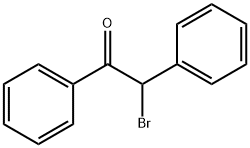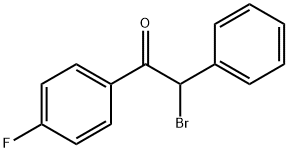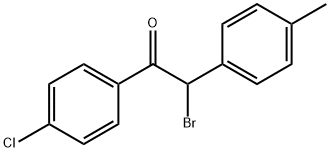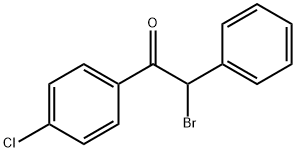2-BROMO-2-PHENYLACETOPHENONE
Synonym(s):2-Bromo-2-phenylacetophenone
- CAS NO.:1484-50-0
- Empirical Formula: C14H11BrO
- Molecular Weight: 275.14
- MDL number: MFCD00000136
- EINECS: 216-057-1
- SAFETY DATA SHEET (SDS)
- Update Date: 2025-09-25 17:15:13

What is 2-BROMO-2-PHENYLACETOPHENONE?
Chemical properties
BEIGE-BROWN CRYSTALLINE POWDER
The Uses of 2-BROMO-2-PHENYLACETOPHENONE
Desyl bromide has been used in:
- synthesis of phosphate esters of benzoin and benzoinyl N-carbobenzyloxyglycylphenylalanate
- novel chemiluminogenic reaction for the sensitive determination of Arg-containing peptides
What are the applications of Application
Desyl bromide is used in the synthesis of phosphate esters of benzoin and benzoinyl N-carbobenzyloxyglycylphenylalanate
Synthesis Reference(s)
Tetrahedron Letters, 20, p. 3653, 1979 DOI: 10.1016/S0040-4039(01)95488-7
General Description
Reaction of cesium N-carbobenzyloxyglycylphenylalanate with desyl bromide in DMF has been investigated.
Properties of 2-BROMO-2-PHENYLACETOPHENONE
| Melting point: | 56-58 °C (lit.) |
| Boiling point: | 344.8±22.0 °C(Predicted) |
| Density | 1.3930 (rough estimate) |
| refractive index | 1.5130 (estimate) |
| storage temp. | 0-6°C |
| solubility | soluble in Toluene |
| form | Crystalline Powder |
| color | Beige-brown |
| CAS DataBase Reference | 1484-50-0(CAS DataBase Reference) |
| EPA Substance Registry System | Ethanone, 2-bromo-1,2-diphenyl- (1484-50-0) |
Safety information for 2-BROMO-2-PHENYLACETOPHENONE
| Signal word | Danger |
| Pictogram(s) |
 Corrosion Corrosives GHS05  Exclamation Mark Irritant GHS07 |
| GHS Hazard Statements |
H314:Skin corrosion/irritation H335:Specific target organ toxicity, single exposure;Respiratory tract irritation |
| Precautionary Statement Codes |
P260:Do not breathe dust/fume/gas/mist/vapours/spray. P271:Use only outdoors or in a well-ventilated area. P280:Wear protective gloves/protective clothing/eye protection/face protection. P301+P330+P331:IF SWALLOWED: Rinse mouth. Do NOT induce vomiting. P303+P361+P353:IF ON SKIN (or hair): Remove/Take off Immediately all contaminated clothing. Rinse SKIN with water/shower. P305+P351+P338:IF IN EYES: Rinse cautiously with water for several minutes. Remove contact lenses, if present and easy to do. Continuerinsing. |
Computed Descriptors for 2-BROMO-2-PHENYLACETOPHENONE
New Products
Indole Methyl Resin tert-butyl 9-methoxy-3-azaspiro[5.5]undecane-3-carboxylate Boc-His(Boc)-OH 2-CTC Resin 4-Chloro-7-tosy1-7Hpyrrolo[2,3-d]pyrimidine 5,7-Dibromo-1H-indole 2,5-dichloro-N-hydroxy-4,6-dimethylpyridine-3-carboximidamide 2,2-Dimethoxy-7-azaspiro[3.5]nonane hydrochloride 4-chloromethyl-5-methyl-1,3-dioxol-2-one (DMDO-Cl) R-2-BENZYLOXY PROPIONIC ACID 1,1’-CARBONYLDIIMIDAZOLE 1,1’-CARBONYLDI (1,2-4 TRIAZOLE) N-METHYL INDAZOLE-3-CARBOXYLIC ACID 4-((2-hydroxyethyl)thio)benzoic acid 1-(TERT-BUTOXYCARBONYL)-2-PYRROLIDINONE Methyl 6-methylnicotinate 3-Pyridineacrylic acid tert-Butyl carbazate TETRAHYDRO-2H-PYRAN-3-OL 2-((4-morpholinophenylamino) (methylthio) methylene) malononitrile 3-(4-morpholinophenylamino)-5-amino-1H-pyrazole-4-carbonitrile 2,4-dihydroxybenzaldehyde 1,3-Diethyl-1,3-Diphenylurea Methyl 2-methylquinoline-6-carboxylateRelated products of tetrahydrofuran








You may like
-
 2-Bromo-2-phenylacetophenone CAS 1484-50-0View Details
2-Bromo-2-phenylacetophenone CAS 1484-50-0View Details
1484-50-0 -
 Desyl bromide CAS 1484-50-0View Details
Desyl bromide CAS 1484-50-0View Details
1484-50-0 -
 Pyridine 99.5% HPLC /UV SpectroscopyView Details
Pyridine 99.5% HPLC /UV SpectroscopyView Details
110-86-1 -
 Piperazine Spot supply, best priceView Details
Piperazine Spot supply, best priceView Details
110-85-0 -
 Dibutyl PhthalateView Details
Dibutyl PhthalateView Details
84-74-2 -
 Imidazole Spot supply, competitive priceView Details
Imidazole Spot supply, competitive priceView Details
288-32-4 -
 Octadecyl 3-(3,5-di-tert-butyl-4-hydroxyphenyl)propionate 98% (GC)View Details
Octadecyl 3-(3,5-di-tert-butyl-4-hydroxyphenyl)propionate 98% (GC)View Details
2082-79-3 -
 Thiourea 99% ARView Details
Thiourea 99% ARView Details
62-56-6
Statement: All products displayed on this website are only used for non medical purposes such as industrial applications or scientific research, and cannot be used for clinical diagnosis or treatment of humans or animals. They are not medicinal or edible.
